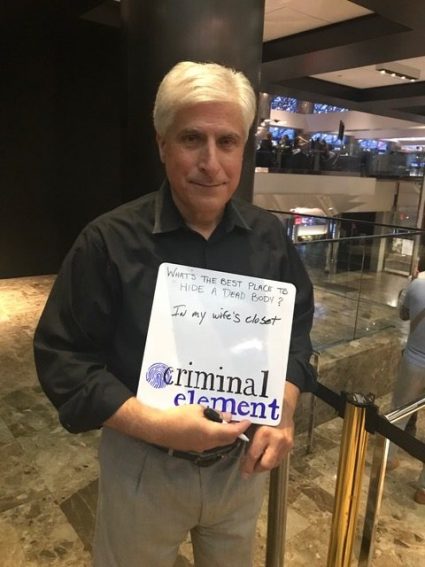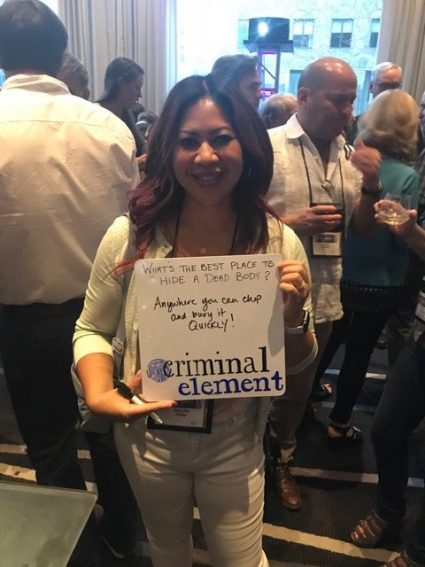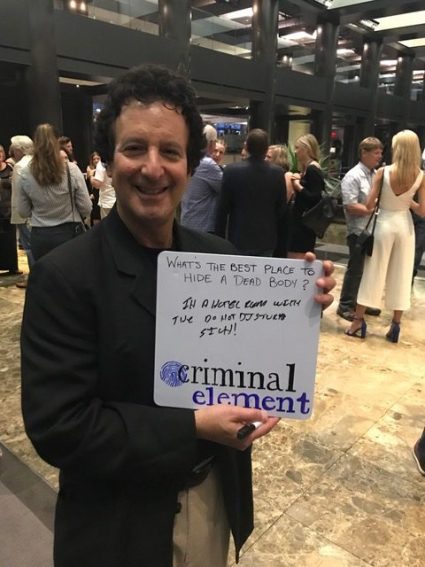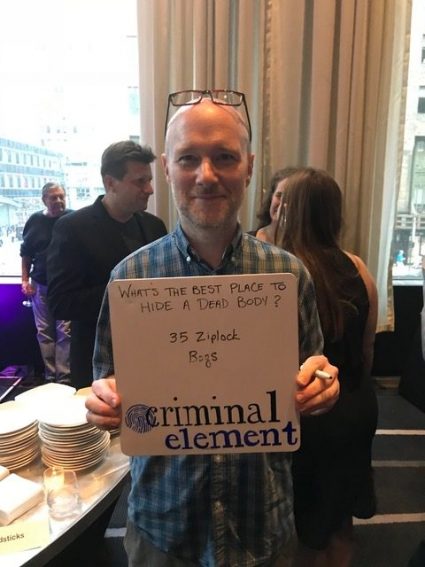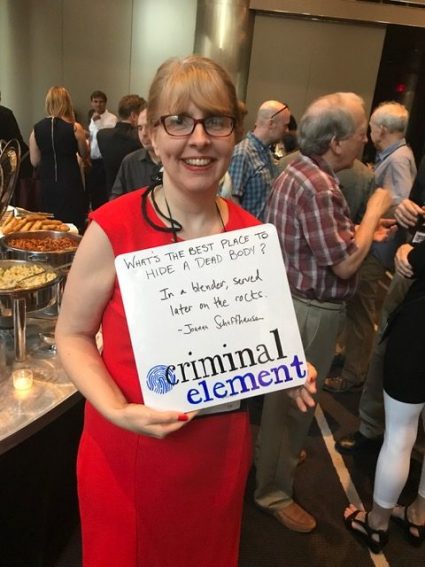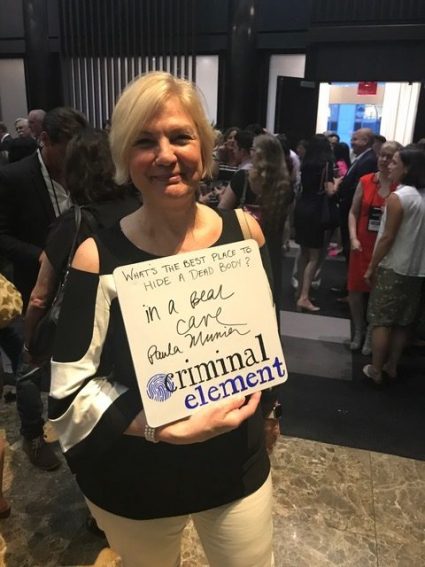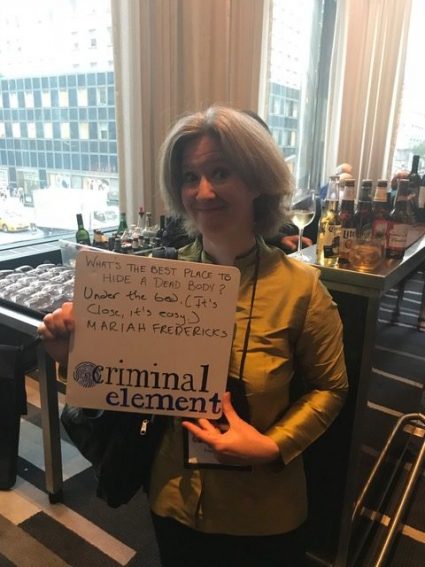2018 Thrillerfest XIII Wrap-Up
By Thomas Pluck
July 17, 2018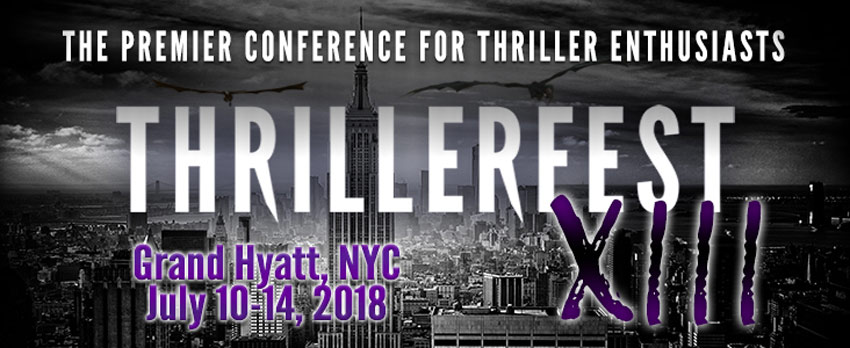
Thrillerfest 2018 was notable for having Thrillermaster George R. R. Martin as the Guest of Honor. He was interviewed by his editor Anne Groell, no questions were allowed, and he held court from the stage in his trademark Mets cap. Really, only a Mets fan could write The Red Wedding, am I right?
Martin discussed writing thrillers like The Armageddon Rag prior to pitching A Game of Thrones with a hundred-page synopsis and also pushed his new history of the House Targaryen, Fire and Blood. Originally to be written by assistants with sidebars by GRRM, his sidebars totaled 350,000 words, so he just wrote it himself from three perspectives—including one by “Mushroom,” a dwarf jester with a massive head who likes to brag about his other endowments. It was somewhat disappointing that the usual “how I made it” section of these interviews was missing because, honestly, that’s why you get invited. This is a business convention, and the personal chats are fun, but at a convention where attending all the panels and events will cost you over a thousand dollars with the early-bird pricing, you are hoping for business-related talk.
We did learn that, like most writers, it was not all cakes and ale for GRRM. He began as a fan writer for an amateur comics zine, and as a boy in Bayonne—a city that has never had a bookstore—he read paperbacks and comics from the spinner rack at the local candy shop. I miss the days of the mass paperback when you could read on the cheap and discover new writers, and I agree with Martin, who decried the recent “stratification of the bookshop.” In the old days, books were books, and they were only vaguely categorized as fiction and nonfiction. The spinners weren’t even categorized—you could find a fantasy next to an adventure next to a romance next to a crime novel next to a political memoir. And we liked it!
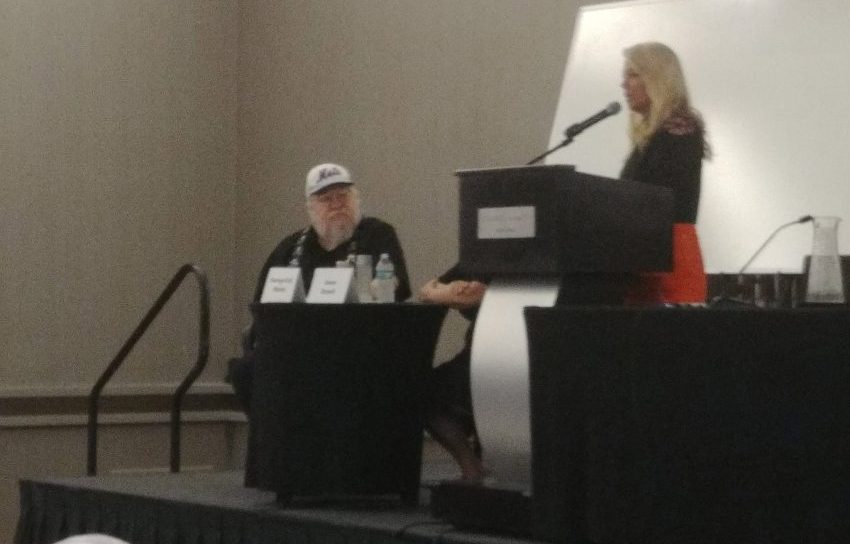
GRRM had a standard career in the beginning until his up-to-then most critically acclaimed novel, the rock ‘n roll fantasy The Armageddon Rag, tanked at the cash register. Despite rave reviews, he couldn’t sell his fifth novel. Luckily, Rag was optioned for film, and he made a good rapport with the producer, who got him a gig writing episodes of the new Twilight Zone and Beauty and the Beast, which paid the bills. When he tired of his pilots and screenplays not getting produced, he returned to novels, and A Game of Thrones was eventually born. By this time, he had enough cred that he could pitch and sell a series with a synopsis because he was a known professional.
Martin spent some time eulogizing his friend, editor, and collaborator Gardner Dozois, a true giant of the science fiction genre who passed away in June. Dozois was best known for reading all the short stories published in eligible SFF magazines when he compiled his encyclopedic anthologies of the Year’s Best Science Fiction, an enormous and laudable feat. It was a full-time job that he performed for decades, and his genre was strengthened by it. He also bought Martin’s first story.
Martin also spoke at length about his SF novel Nightflyers, which stars a superhuman black heroine from his future Thousand Worlds who was always white-faced on the covers of his books. When he mentioned it in 1980, his editor said, “You want to sell books, don’t you?” He said he wished he spoke up more and mentioned that she will be played by a black actor in the Syfy series. But even with GRRM’s clout, the new illustrated edition of Nightflyers doesn’t have a black woman on the cover, just a symbol. That’s how much publishing has moved forward in 38 years: they’ll no longer put a white woman on your book if the character is black, they just won’t put anyone.

So, while this was like a presidential press conference with no questions allowed at the end of the panel or in the signing line—one book, no inscriptions, even though we’re all writers here and the line was maybe 120 deep—GRRM knows how to play an audience. He was funny, genial, and interesting, even while avoiding answering what we all wanted to know: what made him think the Wars of the Roses saga would sell, and how did he go about pitching it? He did leave us with a funny science fiction story where con-goers go skinny dipping in a hotel pool, fully unaware that there were underwater windows opening on the hotel restaurant. My favorite quote of the panel: “I don’t like science fiction set five years in the future where everything is crap. I figure we’ll see that soon enough.”
The other big kahuna event was Megan Abbott interviewed by Lee Child. We learned a lot about Abbott’s start, which began with a Ph.D. thesis on film noir and hardboiled fiction, specifically that of Chandler, Hammett, and Himes. That explains her expert knowledge and handling of the genre. Her mother, writer Patti Nase Abbott, let her skip school and watch gangster movies, and boy did that education pay off. Her first crush was Jimmy Cagney, who may never have said “you dirty rat” but certainly encapsulated the energetic, violent gangster whose charming grin brings his victims in close like the lure of an anglerfish.
She was quite open and honest about her early noir novels being “fan fiction,” where she would put herself into a film noir such as Die a Little, with its teacher protagonist. She then wrote her 42,000-word, trope-flipping masterpiece, Queenpin, based in part on mob courier Virginia Hill, who was forced to testify before Congress where she famously said, “I don’t dance for nobody.” She’s been diminished by being called little more than Bugsy Siegel’s girlfriend, whose long legs gave The Flamingo casino its name, but she was no one’s arm candy, either. Abbott didn’t just flip the King into a Queen, she gave us a “homme fatale” character, which would become a theme in her writing: women and girls brought low by the hypnotic sexuality of a male who has little else to offer but knows how to weaponize his assets.
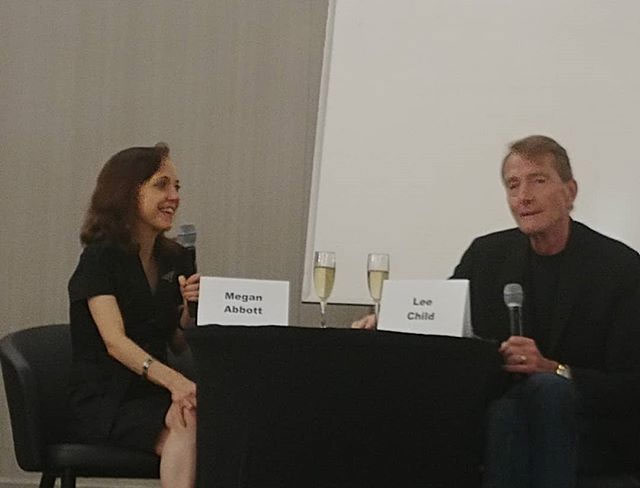
Abbott didn’t so much tire of period pieces as see how little difference there was between noir fatalism and surviving adolescence, where “we barely get out of that period alive.” As with her noir novels, her disappearing-girl story The End of Everything, where a 13-year-old girl looks for her missing friend, was a big hit and a personal favorite. It reads like a fever dream, and Abbott brings the reader back to that confusing, hyper-emotional time for all of us. The prose expertly evokes what it feels like to be that age. And the sexual Venus flytrap isn’t the young girl but an unlikely male figure, as she peels back taboos to show us the visceral insides.
Her next two novels involved a fascination with sports culture, the cheerleader noir Dare Me and the fierce tale of the competitive children’s gymnastics circuit You Will Know Me. They are both strong novels that bring us into worlds where young women are unabashedly competitive and ambitious, while the men are the ones who are little more than a sexy bod wielded to get what they want, whether they act on it or not. We all know men like this, but they are oft unexplored, and Abbott, Laura Lippman (Sunburn), and Alissa Nutting (Made for Love) have been bringing them alive on the page.
Little was said about another favorite of mine, The Fever, which is the Salem Witch Trials brought to a suburban high school after an innocent dip in a local lake leads to mass hysteria after girls keep getting sick. I was, however, delighted to learn that it was based on a lake from Abbott’s childhood where many people drowned despite signs warning them not to swim. I love when a childhood scare resurfaces into a story!
Abbott is a screenwriter on The Deuce, produced by David Simon. As an introvert with a firm writing schedule, she said she was nicknamed “the clockwatcher” because she couldn’t wait until five, no matter how exciting it was working in the room. She worked on screenplays for Dare Me, which she is now the showrunner for, but she won’t be making any Hitchcockian cameos—shame, I think she’d be great as a vicious cheerleader mom in the bleachers. She also gave us one of the best quotes of the convention when talking about writing the screenplay for your own novel: “It’s like an ex moving back into your apartment and not leaving until you solve all your issues.”
Her next novel, out this week, is Give Me Your Hand, which they surprisingly touched on very little! This one is about two rival scientists battling for a position on a research council—a new subculture explored—and it’s as captivating as ever.
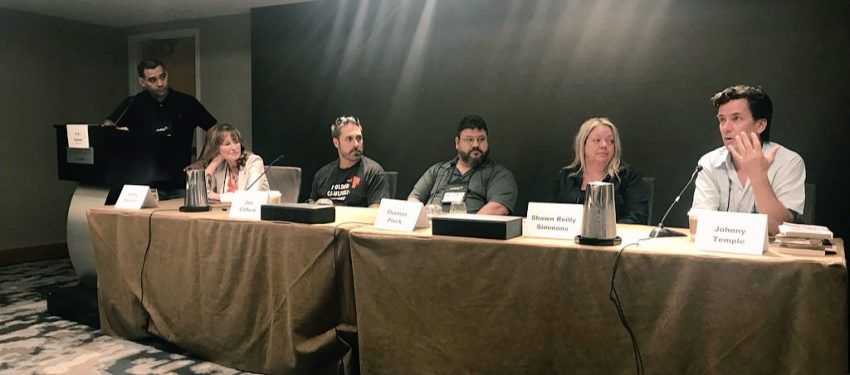
I was on a panel at Thrillerfest for the first time this year: the Anthology panel, led by Panelmaster Ed Aymar, author of I’ll Sleep When You’re Dead and the collaborative novel Night of the Flood. The other panelists were Akashic Books Editor Johnny Temple, who has published nearly a hundred Noir anthologies set all over the world; short story writer and retired law enforcement officer Kathy Bennett; anthologist and organizer of Malice Domestic, Shawn Reilly Simmons; and Joe Clifford, editor of Trouble in the Heartland, an anthology based on Bruce Springsteen songs, and the author of the Jay Porter crime series.
It’s difficult to distill a panel into anything someone would want to read, but to summarize: Themes Are Important. Anthologies need a big hook, more than a novel. The Akashic series has been so successful because Temple takes great pains to make the table of contents and authors “look and feel” like the city itself, representing different neighborhoods, which gives them great breadth. Simmons has been editing the Best New England Crime Stories for 17 years. These, too, are linked by place and tied into the convention—like the Bouchercon anthologies—which give them a hook. My own Protectors anthologies had their charity as a hook, and Clifford’s have the songwriter. George R. R. Martin’s anthologies with Gardner Dozois had strong themes and were cross-genre: Rogues, Dangerous Women, Warriors, etc.
You need broad themes but enough for great diversity in the stories. Unlike, let’s say, “The phone booth on the corner of Main and Marginal in Buttzville” or “The troubles of living in these wild times,” which I’ve seen in anthology calls. Just because it tickles you and a couple friends pink doesn’t mean anyone wants to read about it. Also, follow the damn guidelines. They aren’t guidelines; they are rules.

The Movie Adaptation Panel with Lawrence Block, Peter Blauner, and Matthew Quinn Martin was very educational for any writer hoping to deal with Hollywood. They took great questions from the audience and even saved one guest from taking the poison pill of an open-ended option for little money. That’s not how it works. An option pays for the right to develop your work into a sellable product for a limited amount of time. I’ve had people “one step above a production assistant” (in the words of a blockbuster agent who has sold to the likes of Ridley Scott) try to buy an option for my work by asking “what would you take?” That’s not how it works. If they don’t make you an offer in writing with the words “one year” or similar—whether they get first dibs on renewing and a dollar sign—the response should be, “tug the other one, it’s got bells on,” because they are yanking your respective orb-shaped genital. And this, as well as meeting friends and making new ones, is why you go to Thrillerfest.
Thrillerfest is held annually at the Grand Hyatt New York. The bar talk this year was mostly about how they can charge $76 for breakfast for two with no booze and where you can go drink that’s cheaper than this bar. The crowd was smaller than last year despite the superstar headliner, which I largely chalk up to finances. Thrillerfest can be a very rewarding con if you pick your panels wisely and enjoy visiting Manhattan in the summer. My suggestions: hit as many panels as you can, gather a posse, and find a cheaper bar nearby. There is great food within walking distance. Also, make sure to use the long nights to explore the city if it’s new to you. You’re in the safest part of town as long as you don’t gawk at the Chrysler building with your purse open or wallet hanging out of your left butt pocket.
2018 ITW Thriller Award Winners
Best Hardcover Novel: Final Girls by Riley Sager
Best First Novel: The Freedom Broker by K.J. Howe
Best Paperback Original Novel: Grievance by Christine Bell
Best Young Adult Novel: The Rains by Gregg Hurwitz
Best eBook Original Novel: Second Chance by Sean Black
Best Short Story: “Charcoal and Cherry” by Zoe Z. Dean (Ellery Queen Mystery
Magazine)
Thrillermaster Award: George R. R. Martin
Silver Bullet Award: James Rollins
Thriller Legend Award: Robert and Patricia Gussin
Where Would Your Favorite Authors Hide a Dead Body?
On Thursday night, Minotaur Books hosted a cocktail party to kick off the weekend—and we learned some, well, interesting things about a few of our favorite authors. If any editors or rival authors turn up missing in the next few days … you know where to look.
